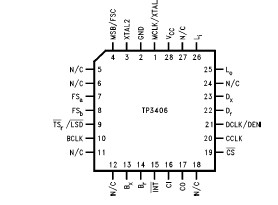TP3406: Features: Complete ISDN PBX 2-Wire Data Transceiver including:` 2 B plus D channel interface for PBX UÊ Interface` 144 kb/s full-duplex on 1 twisted pair using Burst Mode` Loop range up to 800...
floor Price/Ceiling Price
- Part Number:
- TP3406
- Supply Ability:
- 5000
Price Break
- Qty
- 1~5000
- Unit Price
- Negotiable
- Processing time
- 15 Days
SeekIC Buyer Protection PLUS - newly updated for 2013!
- Escrow Protection.
- Guaranteed refunds.
- Secure payments.
- Learn more >>
Month Sales
268 Transactions
Payment Methods
All payment methods are secure and covered by SeekIC Buyer Protection PLUS.

 TP3406 Data Sheet
TP3406 Data Sheet







